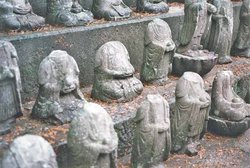Shimabara Rebellion
|
|
Remains_of_Hara_castle.jpg
The Shimabara Rebellion (ja: 島原の乱, shimabara no ran) was an uprising of Japanese peasants, many of them Christians, during the Tokugawa Shogunate in 1637-1638.
Rebellion broke out on (according to western calendar) December 17, 1637 when peasants rose against their daimyo Matsukura Shigeharu. Christians like to emphasize the fact that most rebels were Japanese converted to Christianity but the other prominent reason for the revolt was the very heavy tax burden; many rebels took the mantle of Christianity later.
Rebels included maybe up to 23.000 peasants and ronin, including many women, in Shimabara and nearby Amakusa Islands under the leadership of Amakusa Shiro (also named Masuda Tokisada) who used a Christian name Jerome. Both areas had been under heavy Jesuit missionary activity during the previous Christian daimyo Konishi Yukinaga.
Terazawa Hirotaka, governor of Nagasaki, dispatched an army of 3,000 samurai to Amakusa but rebels defeated them on December 27, 1637 with 2,800 casualties. Survivors retreated to Nagasaki and the governor asked shogunate for reinforcements. However, in battle on January 3, 1638 shogunate warriors defeated the rebels who lost about 1,000. They retreated to Shimabara.
In Shimabara, rebels besieged Shimabara castle and took over the fortress at Hara.

Hirotaka had already left for Shimabara on January 2 with 500 samurai and gathered 800 more from Omura. They made camp half a mile from Shimabara castle. They commenced artillery fire from cannons commandeered from Japanese and Chinese vessels. They then requested aid from a Dutch merchant vessel to bombard the Hara fort from the sea. Rebels shot two Dutch lookouts and the ship withdrew.
Shogunate troops arrived but rebels in Hara fortress resisted siege for months and caused them heavy losses. Both sides had a hard time fighting in winter conditions. On February 3, 1638, a rebel raid killed 2,000 warriors from Hizen including their daimyo. However, they slowly ran out of food, ammunition and other provisions.
On March 10, shogunate forces begun to gather in Shimabara and by April there were 30,000 rebels facing 200,000 shogunate soldiers. Desperate rebels mounted an assault against them on April 4 and were forced to withdraw. Captured survivors revealed the fortress was out of food and gunpowder.
On April 12, 1638, Hizen warriors stormed the fortress and captured the outer defenses. Rebels held out and caused heavy casualties until they were routed on April 15. The Shogunate had lost about 10,000 soldiers.
Afterwards, the shogunate forces beheaded an estimated 37,000 rebels and sympathizers. Amakusa Shiro's head was taken to Nagasaki and Hara fortress was destroyed. The Shogunate suspected that Western Catholics had been involved in spreading the rebellion and Portuguese traders were driven out of the country. An already existing ban on the Christian religion was then enforced stringently, and Christianity in Japan survived only by going underground, turning into something called kakure kirishitan.
From this time until the 1860s, no major battles took place in Japan. During the next ten generations of the Edo period, most samurai never fought in combat.ja:島原の乱 ru:Восстание в Симабара
